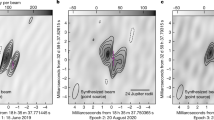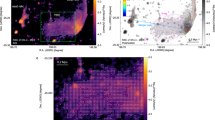Abstract
A number of nearby late-type stars, including the Sun, are known to be active at radio wavelengths. Disregarding mass-loss giant stars and novae (where the emission is probably of thermal origin)1, we find that most radio stars are RSCVn binaries and UV Ceti-type flare stars2. Estimated brightness temperatures >109K suggest that the emission mechanisms are non-thermal, and in some cases coherent3. Non-thermal radio emission from active stars is often moderately circularly polarized. In this respect the emission is similar to solar radiation at metre to centimetre wavelengths and may similarly arise from the acceleration and subsequent trapping of mildly relativistic electrons in intense magnetic fields above star spots. I describe here a radio method which measures the longitudinal magnetic sector structure of the solar corona by observing the Sun ‘as a star’ and monitoring the sense of circular polarization of metre-wavelength emission as a function of rotational phase. The method is tested by comparing synoptic plots of solar radio-noise-storm polarities derived from high- and low-resolution observations over a period of four years at Culgoora. This method may be applied to the measurement of large-scale coronal fields on other active stars.
This is a preview of subscription content, access via your institution
Access options
Subscribe to this journal
Receive 51 print issues and online access
$199.00 per year
only $3.90 per issue
Buy this article
- Purchase on Springer Link
- Instant access to full article PDF
Prices may be subject to local taxes which are calculated during checkout
Similar content being viewed by others
References
Wright, A. E. in Proc. 2nd Asian-Pacific Regional 1AU Meeting on Astronomy (eds Hidayat, B. & Feast, M. W.) 61–73 (Tira Pustaka, Jakata, 1981).
Pallavicini, R., Willson, R. F. & Lang, K. R. Astr. Astrophys. 149, 95–101 (1985).
Dulk, G. A. A Rev. Astr. Astrophys. 23, 169–224 (1985).
Stewart, R. T. Sol. Phys. 96, 381–395 (1985).
Svalgaard, L. & Wilcox, J. M. A. Rev. Astr. Astrophys. 16, 429–443 (1978).
Hoeksema, J. T., Wilcox, J. M. & Scherrer, P. H. J. geophys. Res. 88, 9910–9918 (1983).
Hale, G. E. Astrophys. J. 38, 27–98 (1913).
Cohen, M. R. Astrophys. J. 131, 664–680 (1960).
Steinberg, J. L., Caroubalos, C. & Bougeret, J. L. Astr.Astrophys. 37, 109–115 (1974).
Gibson, D. M., proc. 3rd Cambridge Workshop, Cool Stars, Stellar Systems and the Sun (eds -Balinas, S. L. & Hartmann, L.) 197–201 (Springer, Berlin, 1983).
Mutel, R. L., Lestrade, J.-F. & Doiron, D. J. in Radio Stars (eds Hjellming, R. M. & Gibson, D. M.) 259–265 (Reidel, Dordrecht, 1985).
Gary, D. E. & Linsky, J. L. Astrophys. J. 250, 284–292 (1981).
Kundu, M. R. & Shevgaonkar, R. K. Astrophys. J. 297, 644–648 (1985).
Author information
Authors and Affiliations
Rights and permissions
About this article
Cite this article
Stewart, R. Radio method of mapping large-scale coronal magnetic fields on active stars. Nature 320, 509–510 (1986). https://doi.org/10.1038/320509a0
Received:
Accepted:
Issue Date:
DOI: https://doi.org/10.1038/320509a0
Comments
By submitting a comment you agree to abide by our Terms and Community Guidelines. If you find something abusive or that does not comply with our terms or guidelines please flag it as inappropriate.



